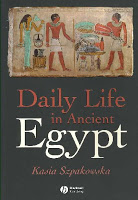Egypt
 Bryn Mawr Classical Review
Bryn Mawr Classical Review
See the above page for the entire review.
- Book Review: Ancient Egyptian Tombs
Bryn Mawr Classical Review (William H. Peck) Steven Snape, Ancient Egyptian Tombs: the Culture of Life and Death. Blackwell ancient religions. Malden, MA; Oxford; Chichester: Wiley-Blackwell, 2011. This work is a rather ambitious attempt to summarize...
- Book Review: Describing And Interpreting The Past
Bryn Mawr Classical Review (Reviewed by Sveta Matskevich) Cătălin Pavel, Describing and Interpreting the Past: European and American Approaches to the Written Record of the Excavation. Bucureşti: Editura Universităţii din Bucureşti While...
- The Father Of All Monks
Al Ahram Weekly (Nevine El-Aref) The world's oldest monastery has had a facelift to smooth out the cracks. Nevine El-Aref sees what the conservationists have been up to “If you want to be perfect, go, sell what you have and give to the poor, and...
- Book Review: Philae And The End Of Ancient Egyptian Religio
Bryn Mawr Classical Review (Reviewed by Robert B. Gozzoli) J. H. F. Dijkstra, Philae and the End of Ancient Egyptian Religion: A Regional Study of Religious Transformation (298-642 CE). Orientalia Lovaniensia Analecta, 173. Leuven: Peeters, 2008. The...
- Book Review: Alexander The Great - A Life In Legend
Bryn Mawr Classical Review There's a table of contents on the above page, together with the rest of the review. Here's an extract: Richard Stoneman, Alexander the Great: A Life in Legend. New Haven, CT/London: Yale University Press, 2008. Reviewed...
Egypt
Book Review: Daily Life in Ancient Egypt
 Bryn Mawr Classical Review
Bryn Mawr Classical ReviewKasia Szpakowska, Daily Life in Ancient Egypt. Recreating Lahun. Malden: Blackwell Publishing, 2008.
Reviewed by Danijela Stefanovic, Faculty of Philosophy, University of Belgrade
Reviewed by Danijela Stefanovic, Faculty of Philosophy, University of Belgrade
This book recreates the daily life of the middle-class inhabitants of Lahun, the settlement of the builders of the nearby pyramid of Senusret II, and one of the most important ancient Egyptian towns, through the reconstruction of the life of the young girl Hedjerit, and her family in the town in the Late Middle Kingdom.
Szpakowska has based her work on written sources and archaeological finds from the settlement of Lahun, as well as from other contemporary settlements and mortuary sites; finds from Lahun are often illustrated with line-drawings or photographs (some published here for the first time). Many of the objects found in Lahun are scattered around museums worldwide, but a large proportion is now in the Petrie Museum in London and in the Manchester Museum.
The book starts with an informative introduction (The Settings), which discusses the geographical and historical setting of Lahun.
Chapter two (Birth) deals with childbirth. As the author notes, "the delivery process itself is an area of life that is generally not documented in detail by any culture, and Ancient Egypt is no exception". However, Szpakowska points out that it is reasonable to suggest that Egyptian women gave birth squatting, or kneeling over a hole, with the feet on two or four birth bricks. Within the same chapter, the issues of infant and maternal mortality, as well as of family size, are also discussed. . . .
Szpakowska's book is well-written, and a valuable addition to books on the topic of daily life in ancient Egypt. It tells a wonderful story of life in an ancient Egyptian town. The author managed to give us a good view of Egyptian society describing the main issues of everyday life of Hedjerit and her family in Lahun: birth, childhood, education, work, religious life, health care, growing up and death. This study aims to make Lahun material accessible not only to Egyptologists and anthropologists but to any interested reader as well, so that we may attempt, in the words of the author, "to follow the life of one individual and her family to help us understand Ancient Egypt."
See the above page for the entire review.
- Book Review: Ancient Egyptian Tombs
Bryn Mawr Classical Review (William H. Peck) Steven Snape, Ancient Egyptian Tombs: the Culture of Life and Death. Blackwell ancient religions. Malden, MA; Oxford; Chichester: Wiley-Blackwell, 2011. This work is a rather ambitious attempt to summarize...
- Book Review: Describing And Interpreting The Past
Bryn Mawr Classical Review (Reviewed by Sveta Matskevich) Cătălin Pavel, Describing and Interpreting the Past: European and American Approaches to the Written Record of the Excavation. Bucureşti: Editura Universităţii din Bucureşti While...
- The Father Of All Monks
Al Ahram Weekly (Nevine El-Aref) The world's oldest monastery has had a facelift to smooth out the cracks. Nevine El-Aref sees what the conservationists have been up to “If you want to be perfect, go, sell what you have and give to the poor, and...
- Book Review: Philae And The End Of Ancient Egyptian Religio
Bryn Mawr Classical Review (Reviewed by Robert B. Gozzoli) J. H. F. Dijkstra, Philae and the End of Ancient Egyptian Religion: A Regional Study of Religious Transformation (298-642 CE). Orientalia Lovaniensia Analecta, 173. Leuven: Peeters, 2008. The...
- Book Review: Alexander The Great - A Life In Legend
Bryn Mawr Classical Review There's a table of contents on the above page, together with the rest of the review. Here's an extract: Richard Stoneman, Alexander the Great: A Life in Legend. New Haven, CT/London: Yale University Press, 2008. Reviewed...
